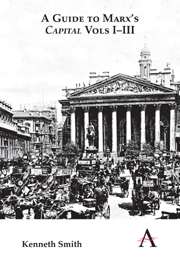Book contents
- Frontmatter
- Contents
- Introduction
- Part I The Development of the Capitalist Mode of Production
- Part II The Capitalist Mode of Production
- 5 Simple Reproduction in Capital, Vol. I, Ch. 7, 11 and 23
- 6 Extended Reproduction in Capital, Vol. I, Ch. 24
- 7 Simple Reproduction in Capital, Vol. II, Sections 1–8
- 8 Extended Reproduction in Capital, Vol. II, Ch. 21, Section 3
- 9 The Precipitation of Fixed Capital in Capital, Vol. II, Ch. 21, Sections 1–2; Ch. 20, Section 11
- Part III The Underdevelopment of the Capitalist Mode of Production
- Part IV The Value Theory of Labour
- Conclusion
- Appendix: On Social Classes
- Notes
- Bibliography
- Index
5 - Simple Reproduction in Capital, Vol. I, Ch. 7, 11 and 23
from Part II - The Capitalist Mode of Production
Published online by Cambridge University Press: 05 May 2013
- Frontmatter
- Contents
- Introduction
- Part I The Development of the Capitalist Mode of Production
- Part II The Capitalist Mode of Production
- 5 Simple Reproduction in Capital, Vol. I, Ch. 7, 11 and 23
- 6 Extended Reproduction in Capital, Vol. I, Ch. 24
- 7 Simple Reproduction in Capital, Vol. II, Sections 1–8
- 8 Extended Reproduction in Capital, Vol. II, Ch. 21, Section 3
- 9 The Precipitation of Fixed Capital in Capital, Vol. II, Ch. 21, Sections 1–2; Ch. 20, Section 11
- Part III The Underdevelopment of the Capitalist Mode of Production
- Part IV The Value Theory of Labour
- Conclusion
- Appendix: On Social Classes
- Notes
- Bibliography
- Index
Summary
If the capitalist-to-be invests a primitively accumulated capital of £1,000, if this capital of £1,000 produces yearly a surplus value of £200, and if further this surplus value of £200 is consumed unproductively by the capitalist in order to reproduce him or herself and his family, then at the end of a period of 5 years the surplus value consumed unproductively (5 × £200 = £1,000) will be equal in value to the £1,000 originally invested and the original capital will in effect have been entirely used up and will exist no more. Similarly, if the capitalistto- be consumes surplus value unproductively at only half the annual rate as that in the above example (i.e. at the rate of only £100 per year), it will take 10 years instead of 5 for the original investment to be consumed unproductively by the capitalist-to-be in the form of his profit on the enterprise. In both cases the result will be the same: if unproductive consumption takes place by the capitalist-to-be and his or her family in order to reproduce themselves and is not put back into the enterprise in some way, there must eventually come a point – whether it is in 5 years time, 10 years or even 50 years – when the original sum invested has been entirely used up during the process of production and is no more.
- Type
- Chapter
- Information
- A Guide to Marx's 'Capital' Vols I-III , pp. 43 - 49Publisher: Anthem PressPrint publication year: 2012

